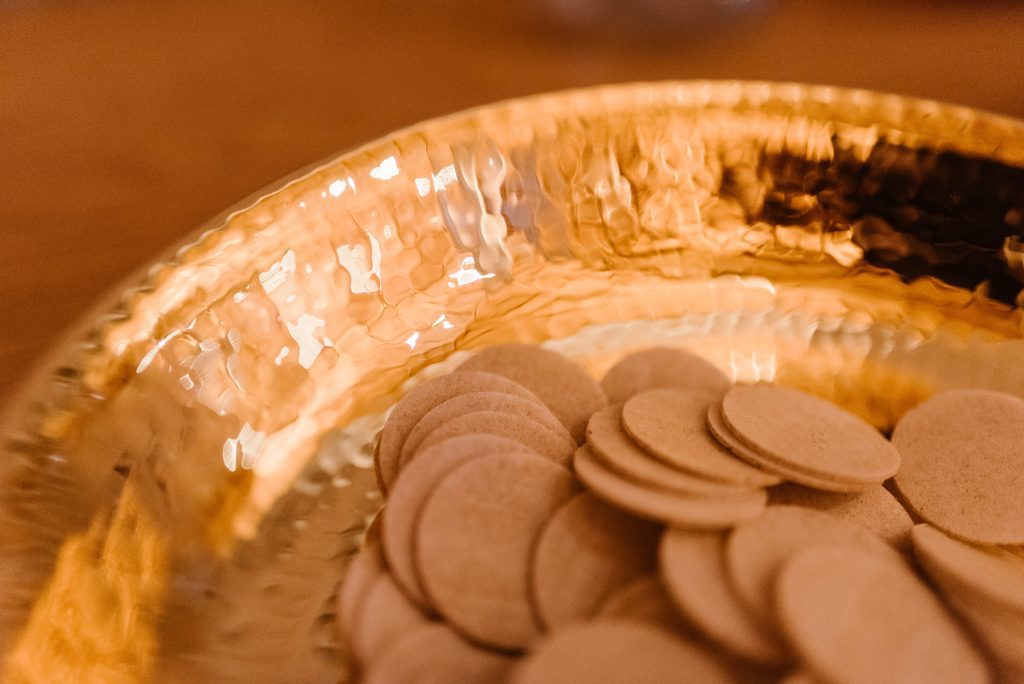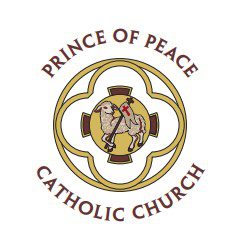The Eucharist is the bread that gives strength… It is at once the most eloquent proof of His love and the most powerful means of fostering His love in us.
Saint Damien of Molokai

If you wish your child to receive their First Holy Communion, a Pope John or Shawe student will receive instructions. If your child attends public school, they will need to attend religious education classes held on Wednesday nights from 6-7 pm at Pope John Elementary. The Parish Office needs to be contacted and your child’s baptismal record will need to be provided.
The Reception of Holy Communion at Mass
The Church understands the Communion Procession, in fact, every procession in liturgy, as a sign of the pilgrim Church, the body of those who believe in Christ, on their way to the Heavenly Jerusalem. All our lives we who believe in Christ are moving in time toward that moment when we will be taken by death from this world and enter into the joy of the Lord in the eternal Kingdom he has prepared for us. The liturgical assembly of the baptized that comes together for the celebration of the Eucharist is a witness to, a manifestation of, the pilgrim Church. When we move in procession, particularly the procession to receive the Body and Blood of Christ in Communion, we are a sign, a symbol of that pilgrim Church “on the way.”
For some, however, the experience of the Communion Procession is far more prosaic, analogous perhaps to standing in line in the supermarket or at the motor vehicle bureau. A perception such as this is a dreadfully inaccurate and impoverished understanding of what is a significant religious action. The Communion Procession is an action of the Body of Christ. At Christ’s invitation, extended by the priest acting in Christ’s person: “Blessed are those called to the supper of the Lamb,” the members of the community move forward to share in the sacred meal, to receive the Body and Blood of Christ which is the sign and the source of their unity. In fact, each time we move forward together to receive the Body and Blood of the Lord, we join the countless ranks of all the baptized who have gone before us, our loved ones, the canonized and uncanonized saints down through the ages, who at their time in history formed a part of this mighty stream of believers.
This action by Christ’s body, the Church assembled for the Eucharist, is manifested and supported by the Communion Chant, a hymn in praise of Christ sung by the united voices of those who believe in him and share his life. The General Instruction of the Roman Missal takes this hymn very seriously, mandating that it should begin at the Communion of the priest and extend until the last person has received Communion.
For some, however, the singing of this hymn is perceived as an intrusion on their own prayer, their private thanksgiving after Communion. In fact, however, this hymn is prayer, the corporate thanksgiving prayer of the members of Christ’s Body, united with one another. Over and over again the prayers of the liturgy and the norms of the General Instruction emphasize this fundamental concept of the unity of the baptized, stressing that when we come together to participate in the Eucharistic celebration we come, not as individuals, but as united members of Christ’s Body. In each of the Eucharistic Prayers, though the petition is worded in slightly different ways, God is asked to send his Holy Spirit to make us one body, one spirit in Christ; the General Instruction admonishes the faithful that “they are to form one body, whether in hearing the Word of God, or in taking part in the prayers and in the singing…” (no. 96). It describes one of the purposes of the opening song of the Mass as to “foster the unity of those who have been gathered” (no. 47), and says of the Communion Chant that “its purpose [is] to express the spiritual union of the communicants by means of the unity of their voices, to show gladness of heart, and to bring out more clearly the ‘communitarian’ character of the procession to receive the Eucharist” (no. 86).
It is difficult for some of us to embrace this emphasis on Mass as the action of a community rather than an individual act of my own faith and piety, but it is important that we make every effort to do so. Christ himself at the Last Supper pleaded with his Father: “Holy Father, keep them in your name that you have given me, so that they may be one just as we are… as you, Father, are in me and I in you, that they also may be in us…” (John 17:11, 21). Baptism has joined us to Christ and to one another as the vine and its branches. The life of Christ, the Holy Spirit, animates each of us individually, and all of us corporately and guides us together in our efforts to become one in Christ.
Finally, the fact that the Communion Procession is a profoundly religious action tells us something about the way in which we should participate in this procession. We are the Body of Christ, moving forward to receive the Christ who makes us one with himself and with one another. Our procession should move with dignity; our bearing should be that of those who know they have been redeemed by Christ and are coming to receive their God!
The General Instruction asks each country’s Conference of Bishops to determine the posture to be used for the reception of Communion and the act of reverence to be made by each person as he or she receives Communion. In the United States, the body of Bishops has determined that “[t]he norm… is that Holy Communion is to be received standing unless an individual member of the faithful wishes to receive Communion while kneeling” and that a bow is the act of reverence made by those receiving (no. 160). This norm is supported by an Instruction by the Holy See regarding the Eucharist: “In distributing Holy Communion it is to be remembered that ‘sacred ministers may not deny the sacraments to those who seek them in a reasonable manner, are rightly disposed, and are not prohibited by law from receiving them’ (Code of Canon Law, can. 843 § 1; cf. can. 915). Hence any baptized Catholic who is not prevented by law must be admitted to Holy Communion. Therefore, it is not licit to deny Holy Communion to any of Christ’s faithful solely on the grounds, for example, that the person wishes to receive the Eucharist kneeling or standing” (Redemptionis Sacramentum, no. 91).
Those who receive Communion may receive either in the hand or on the tongue, and the decision should be that of the individual receiving, not of the person distributing Communion. If Communion is received in the hand, the hands should first of all be clean. If one is right handed the left hand should rest upon the right. The host will then be laid in the palm of the left hand and then taken by the right hand to the mouth. If one is left-handed this is reversed. It is not appropriate to reach out with the fingers and take the host from the person distributing.
The person distributing Communion says audibly to each person approaching, “The Body of Christ.” This formula should not be altered, as it is a proclamation which calls for a response of faith on the part of the one who receives. The communicant should audibly respond, “Amen,” indicating by that response his or her belief that this small wafer of bread, and the wine in this chalice are in reality the body and blood of Christ the Lord.
When one receives from the chalice, the same proclamation is made by the person distributing Communion and the Communicant again responds, “Amen.” It should be noted that it is never permissible for a person to dip the host he or she has received into the chalice. If for some reason, the communicant is not able or willing to drink from the cup then that person should receive only under the form of bread.
It seems appropriate to conclude this reflection on the Communion Procession and the reception of Communion with a quotation from the Catechism of the Catholic Church, no. 1396:
In Baptism we have been called to form but one body. The Eucharist fulfills this call: “The cup of blessing which we bless, is it not a participation in the blood of Christ? The bread which we break, is it not a participation in the body of Christ? Because there is one bread, we who are many are one body, for we all partake of the one bread” (1 Cor 10:16-17).
If you are the body and members of Christ, then it is your sacrament that is placed on the table of the Lord; it is your sacrament that you receive. To that which you are you respond “Amen” (“yes, it is true!”) and by responding to it you assent to it. For you hear the words, “the Body of Christ” and respond “Amen.” Be then a member of the Body of Christ that your Amen may be true (St. Augustine, Sermon 272: PL 38, 1247).
